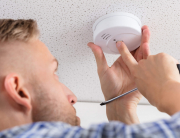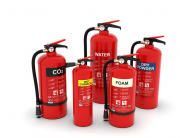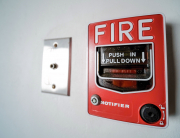Carbon monoxide, often referred to as the “silent killer”, is a colourless, odourless, and tasteless gas that can be produced by everyday household appliances. It’s formed when fuels like gas, oil, coal, and wood don’t burn completely.
The importance of carbon monoxide alarms in preventing poisoning is very crucial. These unassuming devices act as your personal guardians, constantly monitoring the air in your home for this dangerous gas. In the UK alone, there are about 60 deaths each year from accidental carbon monoxide poisoning, with thousands more suffering from CO-related illnesses. While this might sound a bit scary, don’t worry – we’re here to arm you with knowledge and practical tips to keep your home safe.
What is Carbon Monoxide?
Let’s start with the basics. Carbon monoxide is produced when carbon-based fuels don’t burn completely. This incomplete combustion can happen in various household appliances and systems that we use daily. Some common sources of CO in homes include:
- Gas cookers and ovens
- Boilers and central heating systems
- Gas fires and wood-burning stoves
- Fireplaces and chimneys
- Petrol-powered generators
- Car engines running in attached garages
Why is Carbon Monoxide Dangerous?
Carbon monoxide earns its reputation as a silent killer due to its unique characteristics. As mentioned earlier, it’s completely colourless, odourless, and tasteless. This means that without a carbon monoxide detector, you could be exposed to dangerous levels of the gas without even realising it.
But the real danger lies in how CO affects our bodies. Breathing in carbon monoxide binds to the haemoglobin in our blood – the part responsible for carrying oxygen throughout our body. CO binds to haemoglobin much more readily than oxygen, effectively blocking oxygen from getting to where it’s needed. This can lead to oxygen starvation in our tissues and organs, with potentially fatal consequences.
The health risks associated with carbon monoxide exposure can range from mild to severe, depending on the level and duration of exposure. Short-term exposure can cause symptoms like headaches and nausea, while long-term exposure or high concentrations can lead to brain damage, heart problems, and even death.
Symptoms of Carbon Monoxide Poisoning
Recognising the symptoms of carbon monoxide poisoning can be tricky, as they often mimic other common illnesses. However, being aware of these signs could save lives. Here are some common symptoms to watch out for:
- Dizziness
- Headaches
- Nausea and vomiting
- Shortness of breath
- Confusion and disorientation
- Chest pain
- Loss of consciousness
One key indicator of CO poisoning is if these symptoms improve when you leave the affected area and worsen when you return. If multiple people or pets in the same household experience similar symptoms simultaneously, it’s a strong sign that carbon monoxide might be present.
It’s crucial to note that certain groups are more vulnerable to the effects of carbon monoxide. Children, pregnant women, elderly individuals, and those with pre-existing health conditions may experience more severe symptoms or effects from lower levels of exposure. Pets can also be affected by CO poisoning and may show signs before humans do.
Types of Carbon Monoxide Detectors
Now that we understand the risks, let’s talk about our first line of defence: carbon monoxide detectors. These essential devices are designed to alert you when CO levels in your home become dangerous. But how does a carbon monoxide detector work? Most detectors use electrochemical sensors that react to the presence of CO, triggering an alarm when levels become unsafe.
There are several types of carbon monoxide alarms available, each with its own advantages:
- Battery-operated carbon monoxide detectors: These are the most common and easiest to install. They run on batteries, which means they’ll continue to function even during power outages. However, it’s crucial to regularly check and replace the batteries to ensure they’re always operational.
- Hardwired detectors: These are connected directly to your home’s electrical system. While they require professional installation, they offer the advantage of not relying solely on batteries. Many hardwired models also include a battery backup for added security during power cuts.
- Plug-in detectors: These detectors plug directly into a power outlet. They’re easy to install and don’t require any wiring, but they may not be suitable for all areas of your home due to outlet placement.
- Combination smoke and CO detectors: These devices offer dual functionality, detecting both smoke and carbon monoxide. They can be a cost-effective option and reduce the number of devices you need to install and maintain.
When choosing a carbon monoxide alarm, look for models that meet British Standard BS:EN50291:2001 or BS:EN50291:2010. This ensures the detector meets the required safety standards for use in domestic settings.
Installation Guidelines
Proper placement of your carbon monoxide detectors is crucial for effective protection. Here are some key guidelines on where to put carbon monoxide detectors:
- Install at least one detector on each floor of your home, including the basement if you have one.
- Place detectors near sleeping areas, ideally within 5-10 feet of bedroom doors.
- If you have fuel-burning appliances in specific rooms (like a gas boiler or fireplace), install a detector in those rooms as well.
- Mount detectors at head height (about 5 feet from the floor) or higher, as CO mixes evenly with air.
- Avoid placing detectors directly above or beside fuel-burning appliances, in very dusty or humid areas, or in direct sunlight.
Remember, these are general guidelines. Always refer to the manufacturer’s instructions for specific placement recommendations for your particular model.
Maintenance and Testing
Once you’ve installed your carbon monoxide detectors, regular maintenance is key to ensuring they continue to protect you effectively. Here are some important maintenance tips:
- Test your detectors monthly by pressing the test button.
- Replace batteries in battery-operated or battery-backup models at least twice a year. A good rule of thumb is to do this when you change your clocks for daylight saving time.
- Clean your detectors regularly by gently vacuuming or dusting them to remove any debris that might interfere with their operation.
- Replace your carbon monoxide detectors every 5-7 years, or according to the manufacturer’s recommendations. Over time, the sensors in these devices can degrade, making them less effective.
What to Do in Case of CO Alarm Activation
If your carbon monoxide alarm goes off, it’s crucial to act quickly and calmly. Here’s what you should do:
- Open all doors and windows to ventilate the area.
- Turn off all fuel-burning appliances and, if possible, the gas supply at the meter.
- Evacuate the premises immediately. Don’t stop to gather belongings – your safety is paramount.
- Once outside, call the gas emergency number (0800 111 999 in the UK) or the fire service.
- Do not re-enter the property until it’s been declared safe by a professional.
- If anyone is experiencing symptoms of CO poisoning, seek medical attention immediately.
How to Turn Off the Carbon Monoxide Alarm
While it’s crucial to take every activation seriously, there may be times when you need to silence your alarm. Here’s how to turn off the carbon monoxide alarm safely:
- First, ensure that everyone in the house is safe and not experiencing any symptoms of CO poisoning.
- If the alarm is sounding due to low battery or at the end of its lifespan, you can usually silence it by pressing and holding the test/silence button.
- For nuisance alarms (like those caused by cooking fumes), you can typically silence the alarm temporarily using the same method.
- Always ventilate the area well after silencing the alarm.
- If the alarm continues to sound after being silenced, treat it as a real emergency and follow the steps outlined in the previous section.
Remember, never disconnect or remove the batteries from your CO alarm to stop it from sounding. This leaves you unprotected and could have serious consequences.
Protect Your Home from Carbon Monoxide
Carbon monoxide safety is a crucial aspect of home safety that often doesn’t get the attention it deserves. By understanding the risks, installing and maintaining carbon monoxide alarms, and taking preventative measures, you can protect yourself and your loved ones from this silent threat.
Remember, your local fire and rescue service and Health and Safety Executive (HSE) are an invaluable resource for fire and CO safety. Here in Northamptonshire, our Fire and Rescue Authority is committed to keeping our community safe. In case of any fire emergency, don’t hesitate to contact us immediately. We encourage you to familiarise yourself with your nearest fire station – you can find this information on our website.
We also offer a wealth of fire safety resources and can arrange fire safety awareness visits to help you ensure your home is as safe as possible. These visits are an excellent opportunity to get personalised advice and have any questions answered by professionals.
Taking proactive steps towards carbon monoxide safety isn’t just about following regulations or ticking boxes – it’s about creating a safer home environment for you and your family. So why not start today? Check your carbon monoxide detectors, schedule that boiler service you’ve been putting off, or reach out to us for a fire safety awareness visit. Your safety is our priority, and together, we can create safer homes and communities.






